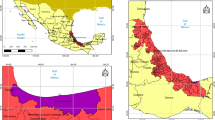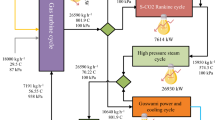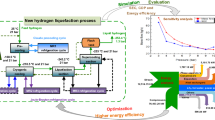Abstract
The analysis of factors affecting the growth of shortage of freshwater is performed. The state and dynamics of the global market of dry coolers used at electric power plants are investigated. Substantial increase in number and maximum capacity of air-cooled condensers, which have been put into operation in the world in recent years, are noted. The key reasons facilitating the choice of developers of the dry coolers, in particular the independence of the location of thermal power plant from water sources, are enumerated. The main steam turbine heat removal schemes using air cooling are considered, their comparison of thermal efficiency is assessed, and the change of three important parameters, such as surface area of heat transfer, condensate pump flow, and pressure losses in the steam exhaust system, are estimated. It is shown that the most effective is the scheme of direct steam condensation in the heat-exchange tubes, but other schemes also have certain advantages. The air-cooling efficiency may be enhanced much more by using an air-cooling hybrid system: a combination of dry and wet cooling. The basic applied constructive solutions are shown: the arrangement of heat-exchange modules and the types of fans. The optimal mounting design of a fully shopassembled cooling system for heat-exchange modules is represented. Different types of heat-exchange tubes ribbing that take into account the operational features of cooling systems are shown. Heat transfer coefficients of the plants from different manufacturers are compared, and the main reasons for its decline are named. When using evaporative air cooling, it is possible to improve the efficiency of air-cooling units. The factors affecting the faultless performance of dry coolers (DC) and air-condensing units (ACU) and the ways of their elimination are described. A high velocity wind forcing reduces the efficiency of cooling systems and creates preconditions for the development of wind-driven devices. It is noted that global trends have a significant influence on the application of dry coolers in Russia, in view of the fact that some TPP have a surface condensers arrangement. The reasons that these systems are currently less efficient than the direct steam condensation in an air-cooled condenser are explained. It is shown that, in some cases, it is more reasonable to use mixing-type condensers in combination with a dry cooler. Measures for a full import substitution of steam exhaust heat removal systems are mentioned.
Similar content being viewed by others
References
Air-Cooled Condenser Design, Specification, and Operation Guidelines. Final Report Electric Power Res. Inst USA, 2005. https://publicdownload.epri.com/ PublicDownload.svc/product=000000000001007688 (2013).
The World’s Largest Power Plants: The Top 100–Part IV Power Plants around the World Photo Gallery, 2014. http://www.industcards.com/top-100-pt-4.htm (2015)
ModuleAir™ air cooled condenser, SPX Cooling Technol. 2014. http://spxcooling.com/pdf/uk_IN-Dry- MA2-14.pdf (2015).
B. A. Tikhonov, Extended Abstract of Candidate Sci. (Eng.) Dissertation (Moscow, 1973).
L. Heller and L. Forgo, “Erfahrungen mit einer Luftgekiihltem Kraftwerks-Kondensationsanlage,” Allgemeine Warmetechnik, No. 5, 3–8 (1956).
Calculation and Design of Air-Condensed Plantd of Heller System (Transelektro, Budapest, 1968) [in Russian].
GEA Air-cooled Heat Exchangers, GEA Batignolles Technol. Therm. http://wwwgea-heatexchangerscom/ about/companies/gea-batignolles-technologies-thermiques- sas/?eID=downloadManager&downloaded= 3451dee5f06181e9aec2bea9aeb9deec (2015).
Air Cooled Vacuum Steam Condensers, GEI Ind. Syst., 2010. http://wwwgeiindcom/acscphp (2015).
Air–Cooling Plants, Belgaspromdiegnostika–GEA Luftkuhler Official Representative, Belarus Repub., Minsk. http://diagby/data/files/catalog_gea1pdf (2015).
HELLER System References, (GEA EGI Contracting/ Eng. Budapest, 2013. http://wwwgea-heatexchangers. com/products/dry-cooling-systems/heller-indirectdry- cooling-systems/?eID=downloadManager&downloadID= f6b6912adab65b9e1140be2a59d7babd (2015).
O. O. Mil’man and V. A. Fedorov, Air-Condensation Plants, (MEI, Moscow, 2002) [in Russian].
“Air cooled condensers (ACC),” in GEA Heat Exchangers, 2012. http://wwwgea-heatexchangers. com/products/dry-cooling-systems/air-cooledcondensers/?eID=downloadManager&downloadID=27c89edb5dd 2a44a1d5b2c9f8d08d 3ea (2015).
“Air cooled condensers. Efficient performance in highly environmental dry cooling,” in Clyde Bergemann Termotec, 2013. http://wwwcbpgcom/sites/default/ files/public%3A/products_solutions/energy_recovery/ CBT-ACC-en-web%20130415pdf (2015)
Dry and Parallel Condensing Systems, http://mydocsepricom/docs/publicmeetingmaterials/ 11-26-2012/Rasmussen-Eric-SPXpdf (2015).
J. S. Maulbetsch, Water Conserving Cooling Systems–Air-cooled Condensers, (ARPA-E Workshop, 2012). http://arpaeenergygov/sites/default/files/documents/ files/4%20Power%20Plant%20Cooling%20State%20 of%20the%20Art%20Maulbetsch%20120321_Possible% 20Slides_lo_respdf (2015).
V. A. Fedorov and O. O. Mil’man, Condensers of Vapor- Turbine Plants, (MGTU, Moscow, 2013) [in Russian].
O. O. Mil’man, V. A. Fedorov, E. I. Lavrov, V. A. Demochkin, A. V. Gerasimov, N. I. Serezhkin, and I. A. Khochkin, “Air-cooled condensers for low and medium-capacity-turbine plants,” Therm. Eng. 45 (1), 39–44 (1998).
O. O. Milman, D. B. Spalding, and V. A. Fedorov, “Steam condensation in parallel channels with nonuniform heat removal in different zones of heat-exchange surface,” Int. J. Heat Mass Transfer 55, 6054–6058 (2012).
Energetic Equipment Catalog (Gazoturb. Tekhnol., Moscow, 2015) [in Russian].
Author information
Authors and Affiliations
Corresponding author
Additional information
Original Russian Text © O.O. Milman, P.A. Anan’ev, 2016, published in Teploenergetika.
Rights and permissions
About this article
Cite this article
Milman, O.O., Anan’ev, P.A. Dry сoolers and air-condensing units (Review). Therm. Eng. 63, 157–167 (2016). https://doi.org/10.1134/S004060151603006X
Published:
Issue Date:
DOI: https://doi.org/10.1134/S004060151603006X




